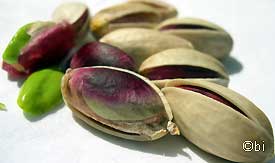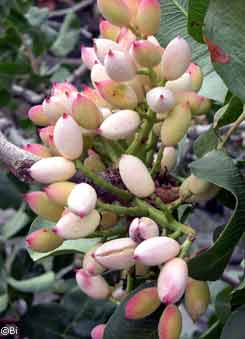Bronte's Pistachio
The Fruit  The green pistachio of Bronte could very well be the emblem of the city: its longevity and resistance, the tenacity to survive against all adversities, even to bear fruits although growing on arid lava rocks reflects, on the long run, many characteristics of the brontese people. The green pistachio of Bronte could very well be the emblem of the city: its longevity and resistance, the tenacity to survive against all adversities, even to bear fruits although growing on arid lava rocks reflects, on the long run, many characteristics of the brontese people.
A people who is not afraid of work and toil, that has always fought to bring home something: that on the pistachio has accumulated wealth, culture and traditions but also respect for the territory in which they live. The pistachio fruits, reunited in clusters, are egg-shaped with dimensions similar to olives and of a reddish color that ripening becomes reddish - green or rosy-white or yellow - cream. Has a subtle skin that crumbles easily, a long and narrow husk and a unique, aromatic and light-green seed. When it is eaten fresh, the taste of the fruit is extremely pleasant.
The various phases of development of the brontese pistachio, from flower to fruit and some stages of ripening. The period goes from May to September. The picking, every two years, is done during the first weeks in September of the uneven years.
Pistachio. the Italian varieties
 The Italian varietal panorama is rather limited and refers to the cultivars of the Sicilian germplasm: “Bianca” (synonym: Napoletana), “Femminella”, “Natalora” and “Agostana”. Bianca practically represents the only cultivated variety, the others have a mainly local diffusion. The Italian varietal panorama is rather limited and refers to the cultivars of the Sicilian germplasm: “Bianca” (synonym: Napoletana), “Femminella”, “Natalora” and “Agostana”. Bianca practically represents the only cultivated variety, the others have a mainly local diffusion.
Other cultivars of lesser interest are "Silvana", "Cerasola", "Cappuccia" and "Insolia", with overall carpological characteristics very similar to Bianca: medium-small fruit, elongated to oval shape, low percentage of dehiscence, green color of the cotyledons. A local green variety, grown in Western Sicily, of some interest due to its high dehiscence is "Gloria". The varietal panorama of male cultivars is even more restricted. Only recently has attention begun to be paid to the problem of the selection and evaluation of male genotypes of P. vera, while until a few years ago it was a common notion among farmers that the male terebinth constituted the natural pollinator of pistachio. From investigations conducted in numerous pistachio groves in the Etna area, it emerged that in some plants the male plants of P. vera do not exceed 1% of the total of those cultivated, while it is known that an optimal male/female ratio is 1 to 8. In Sicilian pistachio-growing areas, spontaneous male terebinths tend to flower significantly earlier than female plants of the "Bianca" cultivar, with negative consequences on pollination and, therefore, on fruiting. Furthermore, it is now established that terebinth pollen has a lower fertilizing capacity towards female pistachio flowers than towards male Pistacia vera. (Source Following Pistachio Footprints) |